Lesson 12.2: Evidence for Evolution
Lesson 12.2: Evidence for Evolution
Lesson Objectives
Clarify the significance of a scientific theory.
Recognize that Darwin supported his theory with a great deal of evidence, and that many kinds of evidence since his time have further strengthened the theory of evolution.
Describe how Darwin used the fossil record to support descent from common ancestors.
Compare and contrast homologous structures and analogous structures as evidence for evolution.
Give examples of evidence from embryology which supports common ancestry.
Explain how vestigial structures support evolution by natural selection.
Discuss the molecular similarities found in all species of organisms.
Describe how evolution explains the remarkable molecular similarities among diverse species.
Analyze the relationship between Darwin’s Theory of Evolution and more recent dis- coveries such as Mendel’s work in genetics and the molecular biology of DNA and protein.
Relate the distribution of plants and animals to changes in geography and climate.
Explain how biogeography supports the theory of evolution by natural selection.
Summarize the explanation given by both Darwin and Wallace for the distribution of few, closely related species across island chains.
You are probably aware that the concept of evolution still generates controversy today, despite its wide acceptance. In The Origin of the Species, Darwin mentioned humans only once, predicting, ”Light will be thrown on the origin of man and his history.” Nevertheless, some people immediately distorted its far-reaching message about the unity of life into near- sighted shorthand: humans “came from” monkeys (Figure 12.13).

In the last lesson, you learned that evolution relates all of life – not just humans and monkeys. In this lesson, you will learn that biological evolution, like all scientific theories, is much more than just an opinion or hypothesis, it is based on evidence.
In science, a theory is an explanation which ties together or unifies a large group of ob- servations. Scientists accept theories if they have a great deal of supporting evidence. In The Origin of the Species, Darwin took the time to compile massive amounts of fossil and biological evidence to support his ideas of natural selection and descent from common an- cestors. He clearly and effectively compared animal breeding (artificial selection), which was familiar to most people, and natural selection. Because Darwin provided so much evidence and used careful logic, most scientists readily accepted natural selection as a mechanism for change in species. Since Darwin’s time, additional fossil and biological data and new fields of biology such as genetics, molecular biology, and biogeography have dramatically confirmed evolution as a unifying theory – so much so that eminent biologist Theodosius Dobzhansky wrote that “Nothing in biology makes sense except in the light of evolution.”
In this lesson, you can explore and evaluate for yourself the many kinds of evidence which support the theory of evolution by natural selection. You will also have the opportunity to appreciate the power of evolution to explain observations in every branch of biology.
The Fossil Record: Structural Changes Through Time
Few would argue that dinosaurs roamed Earth in the past, but no longer exist. The fossil record is a revealing window into species that lived long ago. Paleontologists have care- fully analyzed the preserved remains and traces of animals, plants, and even microorganisms to reconstruct the history of life on Earth (see the History of Life chapter for more detail). Relative (rock layer position) and absolute (radioisotope) dating techniques allow geol- ogists to sequence the fossils chronologically and provide a time scale. Geology also reveals the environmental conditions of past species.
For many reasons, the fossil record is not complete. Most organisms decomposed or were eaten by scavengers after death. Many species lacked hard parts, which are much more likely to fossilize. Some rocks and the fossils they contained have eroded and disappeared. Moreover, much of evolution happens in the small populations that survive changes in en- vironmental conditions, so the chance that intermediates will fossilize is low. Nevertheless, the current record includes billions of fossils – over 300 million from Los Angeles’ LaBrea Tar Pits alone, and an estimated 800 billion in South Africa’s Beaufort Formation. Analysts have identified 250,000 species among these remains.
Although the fossil record is far more detailed today than in Darwin’s time, Darwin was able to use it as powerful evidence for natural selection and common descent. Throughout geo- logical history, species that appear in an early rock layer disappear in a more recent layer. Darwin argued that a species’ appearance recorded its origin, and that its disappearance showed extinction. Moreover, he noted remarkable similarities among structures in differing species, supporting common ancestry. Finally, he could often correlate environmental con- ditions with structures, supporting his idea that natural selection led to adaptations which improved survival within certain habitats.
As an example, let’s analyze a relatively complete set of fossils which record the evolution of the modern horse. Figure 12.14 sequences five species which show major evolutionary changes. The oldest fossil shows a fox-sized animal with slender legs and nearly vertical digits: Hyracotherium bit and chewed soft leaves in wooded marshlands. Geology and paleontology suggest that the climate gradually dried, and grasslands slowly replaced the marshes. Meso- hippus was taller, with fewer, stronger digits – better able to spot and run from predators, and thus more likely to survive and reproduce in the new grasslands. Merychippus was taller
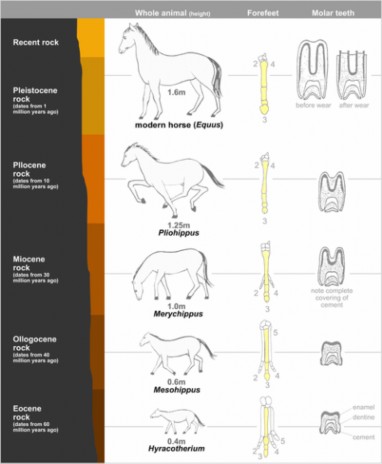
still, and kept only one, enlarged digit – a hoof to run fast on the hard ground. By Pliohippus time, molar teeth had widened and elongated to grind the tough grasses. These fossils show gradual structural changes which correspond to changes in the environment. They appear to show a smooth, linear path directed toward the “goal” of the modern horse, but this is deceiving. These five fossils are merely “snapshots” of a bushy family tree containing as many as 12 genera and several hundred species. Some transitions are smooth progressions; others are abrupt. Together, they support natural selection and descent with modification from common ancestors.
Comparative Anatomy and Embryology
The evidence Darwin presented in The Origin of Species included not only fossils but also detailed comparisons of living species at all life stages. Naturalists in Darwin’s time were ex- perts in comparative anatomy – the study of the similarities and differences in organisms’ structures (body parts). At different times during his life, Darwin studied the comparative anatomy of closely related species of marine mammals, barnacles, orchids, insectivorous plants, and earthworms.
Species which share many similarities are closely related by a relatively recent common ancestor. For example, all orchids share parallel-veined leaves, two-sided flowers with a “lip,” and small seeds (Figures A and B 12.15). Species which share fewer similarities, sharing only basic features, are related by relatively distant ancestor. The sundew, one of the insectivorous plants Darwin studied, shares leaves and petals with orchids, but the leaves are wide with branching veins and the flowers are radially symmetrical rather than two-sided (Figure C 12.15). The many species of orchids, then, share a recent common ancestor, but they also share a more distant ancestor with the sundew.
Homologous and Analogous Structures
Similarities can show two different kinds of relationships, both of which support evolution and natural selection.
-
Similarities shared by closely related species (species who share many characteristics) are homologous, because the species have descended from a common ancestor which had that trait. Homologous structures may or may not serve the same function. Figure 12.16 shows the forelimbs of mammals, considered homologous because all mammals show the same basic pattern: a single proximal bone joins a pair of more distal bones, which connect to bones of the wrist, “hand,” and digits. With this basic pattern, bats build wings for their lives in the air, whales form fins for their lives in the sea, and horses, as we have seen, construct long, hoofed legs for speed on land. Therefore, homologous structures support common ancestry.
-
Similarities shared by distantly related species may have evolved separately because they live in similar habitats. These structures are analogous because they serve similar functions,

but evolved independently. Figure 12.17 compares the wings of bats, bird, and pterosaurs. Bats evolved wings as mammals, pterosaurs as dinosaurs, and birds from a separate line of reptiles. Their wings are analogous structures, each of which evolved independently, but all of which suit a lifestyle in the air. Note that although the wings are analogous, their bones are homologous: all three share a common but more distant vertebrate ancestor, in which the basic forelimb pattern evolved. Because analogous structures are independent adaptations to a common environment, they support natural selection.
Embryology
Embryology is a branch of comparative anatomy which studies the development of verte- brate animals before birth or hatching. Like adults, embryos show similarities which can support common ancestry. For example, all vertebrate embryos have gill slits and tails, shown in Figure 12.18. The “gill slits” are not gills, however. They connect the throat to the outside early in development, but in many species, later close; only in fish and larval amphibians do they contribute to the development of gills. In mammals, the tissue between the first gill slits forms part of the lower jaw and the bones of the inner ear. The embryonic tail does not develop into a tail in all species; in humans, it is reduced during development to the coccyx, or tailbone. Similar structures during development support common ancestry.

Figure 12.16: Homologous structures are similarities throughout a group of closely related species. The similar bone patterns in bat’s wings, dolphin’s flippers, and horse’s legs support their descent from a common mammalian ancestor. (13)

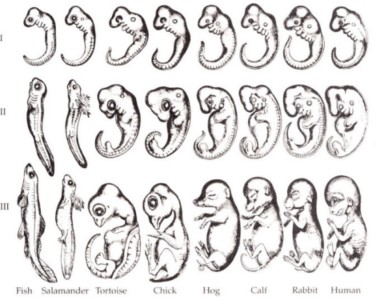
Figure 12.18: Comparative embryology reveals homologies which form during develop- ment but may later disappear. All vertebrate embryos develop tails, though adult humans retain only the coccyx. All vertebrate embryos show gill slits, though these develop into gill openings only in fish and larval amphibians. In humans, gills slits form the lower jaw and Eustachian tube. Many scientists consider developmental homologies evidence for an- cestry, although some embryologists believe that these particular drawings exaggerate the similarities. (8)
Structures which are reduced and perhaps even nonfunctional, such as the human tail and the human appendix, are considered vestigial structures. The tail, of course, functions for balance in many mammals, and the human appendix may have served digestive functions in herbivorous ancestors. Whales, which evolved from land mammals, do not have legs or hair as adults; both begin to develop in embryos, but then recede. Vestigial leg bones remain, buried deep in their bodies, shown in Figure A 12.19.
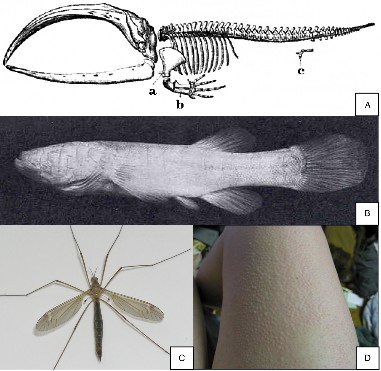
True flies have reduced the second pair of wings found in most insects to halteres for balance shown in Figure B 12.19. Cavefish lose both eyes and pigment, because both would require energy to build and are useless in the lightless habitat they have adopted shown in Figure C
12.19. You are probably very familiar with a fine example of a vestigial behavior: goosebumps raise the sparse hairs on your arms even though they are no longer sufficiently dense to insulate you from the cold by trapping warm air next to your skin; in most mammals, this reflex is still quite functional shown in Figure D 12.19. Most vestigial structures ar homologous to similar, functioning structures in closely related species, and as such, support both common ancestry and (incomplete!) natural selection.
Molecular Biology
Did you know that your genes may be 50% the same as those of a banana?
Unknown in Darwin’s time, the “comparative anatomy” of the molecules which make up life has added an even more convincing set of homologies to the evidence for evolution. All living organisms have genes made of DNA. The order of nucleotides – As, Ts, Cs, and Gs - in each gene codes for a protein, which does the work or builds the structures of life. Proteins govern the traits chosen (or not) in natural selection. For all organisms, a single Genetic Code translates the sequence of nucleotides in a gene into a corresponding chain of 20 amino acids. By itself, the universality of DNA genes and their code for proteins is strong evidence for common ancestry. Yet there is more.
If we compare the sequence of nucleotides in the DNA of one organism to the sequence in another, we see remarkable similarities. For example, human DNA sequences are 98-99% the same as those of chimpanzees, and 50% the same as a banana’s! These similarities reflect similar metabolism. All organisms have genes for DNA replication, protein synthesis, and processes such as cellular respiration. Although metabolic processes do not leave fossils, similar DNA sequences among existing organisms provide excellent evidence for common ancestry.
The differences in DNA sequences are even more intriguing. Many are single base sub- stitutions resulting from mutations accumulated through time. Assuming mutations occur randomly, the number of differences in bases between any two species measures the time elapsed since two organisms shared a common ancestor. This type of ”molecular clock” has confirmed traditional classification based on anatomy. Most scientists consider it sufficiently powerful to clarify or correct our understanding of evolutionary history. For example, human DNA differs 1.2% from chimpanzees, 1.6% from gorillas, and 6.6% from baboons; we can infer from this data that humans and chimpanzees share a relatively recent common ances- tor, and that the common ancestor we share with gorillas lived much longer ago. Figure
shows a cladogram depicting hypothetical evolutionary relationships constructed with this data. Similarities and differences in the sequences of amino acids in proteins support common ancestry in the same way, because they are determined by DNA.
Heritability and variation in traits are essential parts of Darwin’s theory of evolution by natural selection. Since he published The Origin of the Species, rediscovery of Mendel’s identification of genes and how they are inherited has confirmed Darwin’s ideas. Molecular biology has clarified the nature of genes and the sources of variation. Comparative analysis of DNA and proteins continues to give us an exquisitely detailed view of patterns of variation, common ancestry, and how evolution works.
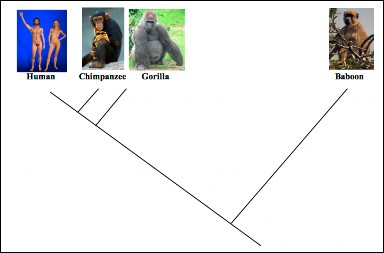
Biogeography
Australia, Africa, and South America occupy the same latitude, at least in part, and therefore have roughly the same climate. If plants and animals were distributed only according to their adaptations to habitat, we would expect the same species to occupy similar regions of these continents. However, the short-tailed monkeys, elephants, and lions in Africa differ significantly from the long-tailed monkeys, llamas, and jaguars of South America, and even more from the koalas, kangaroos, and Tasmanian devils of Australia. Biogeography studies the distribution of plants and animals and the processes that influence their distribution – including evolution and natural selection. Only geologic change and evolution can explain the distributions of many species, so biogeography is another kind of evidence for the theory of evolution.
Alfred Russel Wallace, who developed his own ideas of evolution and natural selection at the same time as Darwin, explained the distributions of many species in terms of changes in geography (such as formation of land bridges) and environment (for example, glaciations) and corresponding evolution of species. Figure 12.21 shows the six biogeographical regions he identified: Nearctic, Neotropical, Palaearctic, Ethiopian, Oriental, and Australian.
Let’s consider just the camel family as an example, shown in Figure 12.22 of how biogeog- raphy explains the distribution of species. Fossils suggest that camel ancestors originated in North America. Distant fossils show structural similarities which suggest that their de- scendants migrated across the Bering land bridge to Asia and across the Isthmus of Panama into South America. These two isolated populations evolved in different directions due to
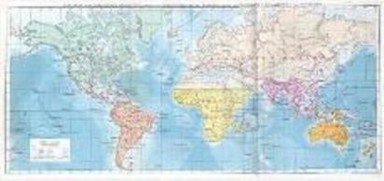
differences in chance variations and habitat. Today’s descendants are llamas and guanacos in South America, and camels in Asia. Asian camels continued to migrate west into Africa, giving rise to two species – the dromedary in Africa, and the Bactrian in eastern Asia.
The distribution of some older fossils shows an opposite pattern; for example, fossils of a single species of fern, Glossopteris, have been found in South America, Africa, India, Antarctica, and Australia (Figure 12.23). Putting together many such distributions and a great deal of geologic data, Alfred Wegener showed that the continents were long ago united as Gondwanaland, and have since drifted apart. His theory of continental drift and its modern form, plate tectonics, help to further explain patterns of evolutionary descent in space and time.
Island Biogeography
Island biogeography studies archipelagos (oceanic island chains) as isolated sites for evo- lution. Both Darwin and Wallace used examples from isolated oceanic islands, such as the Galapagos and Hawaii, in their arguments for evolution and natural selection. Until hu- mans arrived, terrestrial mammals and amphibians were completely absent on these islands. Darwin and Wallace showed that the animals and plants which were present had blown or drifted from one of the continents, or had descended – with modifications which suited the new habitats – from one of the original colonists. Terrestrial mammals and amphibians, hav- ing no powers of dispersal across oceans (until humans came along), were understandably absent.
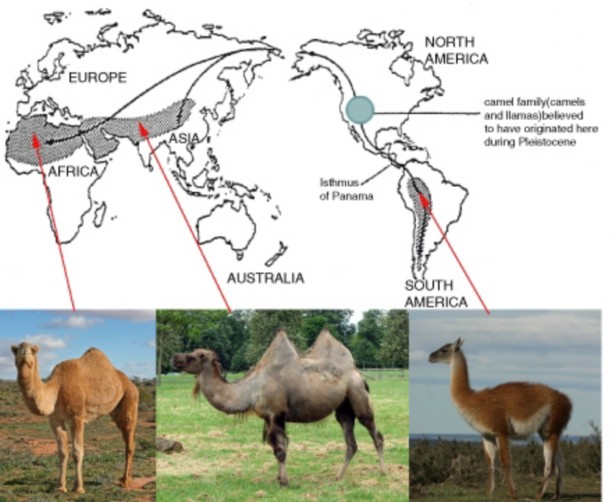

Only long after returning from his voyage did Darwin, with help from ornithologist John Gould, realize that the Galapagos birds he had collected but dismissed as uninteresting blackbirds, grosbeaks, finches, and a wren, were actually all closely related descendants of a single ancestral finch which had relatives on the South American mainland. Careful analysis showed that each of the 12 new species was confined and adapted to a specific habitat on a specific island. The finches, now known as “Darwin’s finches” (Figure A 12.24), clearly support both descent with modification and natural selection. Hawaiian honeycreepers (Figure B 12.24) are a more colorful but also more endangered example of the same evolutionary process of adaptive radiation. Bills ranging from thick and heavy (finch- like) for seed-eaters to long and curved for probing flowers illustrate the variations by which descendants of a single, original finch-like colonizer adapted to multiple ecological niches on the islands. Unfortunately, human destruction of habitat and introductions of rodents, the mongoose, and the mosquito which carries avian malaria have caused the extinction of 15 honeycreeper species, and still threaten the species which remain.
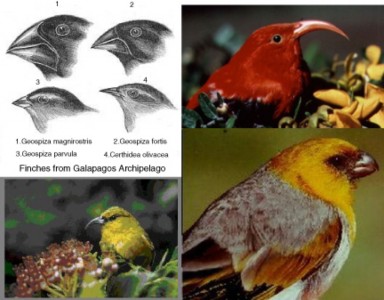
Altogether, the fossil record, homologies, analogies, vestigial structures, molecular unifor- mity and diversity, and biogeography provide powerful scientific evidence for the descent of today’s species from common ancestors. Some details of natural selection have been and are still being modified. However, the remarkable biological discoveries of the 150 years since Darwin published The Origin of the Species have dramatically strengthened support for his theory. Moreover, Darwin’s theory continues to enlighten new discoveries. Perhaps we could paraphrase Dobzhansky: Everything in biology makes sense in the light of evolution. The only piece still missing from the evidence puzzle is direct observation of the process itself. Darwin thought that humans could never witness evolution in action because of the vast time periods required. For once, however, he was mistaken; evolution in action is the subject of the next lesson.
Lesson Summary
Evolution is not “just a theory” as a scientific theory, it explains and unifies the entire field of biology and has a great deal of evidence supporting it.
The evidence includes the comparisons and observations Darwin included in his Origin,
and new knowledge from genetics and molecular biology, added since the Origin was published.
Darwin used the fossils known in his time as evidence for his ideas, and today’s record is even more convincing.
Often, fossil species first appear in older rocks, and disappear in younger rocks, pro- viding evidence that species change.
Changes in climate indicated by geology correlate with changes in fossil species and their adaptations, supporting the idea of natural selection.
The fossil record for horses shows gradual changes which correspond to changes in the environment.
Many basic similarities in comparative anatomy support recent common ancestry.
Similarities in structure for closely related species are homologous.
Similarities in structure among distantly related species are analogous if they evolved independently in similar environments. They provide good evidence for natural selec- tion.
Examples of evidence from embryology which supports common ancestry include the tail and gill slits present in all early vertebrate embryos.
Vestigial structures are reduced and perhaps even nonfunctional, but homologous to fully developed and functional similar structures are in a closely related species; these support the idea of natural selection.
Cavefish without sight or pigment and humans with goose bumps illustrate the concept of vestigiality.
The universality of DNA for genes, amino acids to build protein enzymes and the Genetic Code is strong evidence for common ancestry.
Similarities in metabolic pathways such as DNA replication and transcription and cellular respiration are further evidence for common ancestry.
Within these similarities are differences in the sequence of As, Ts, Cs, and Gs due to the accumulation of mutations.
Comparison of DNA sequences supports descent with modification and can be used to clarify evolutionary relationships.
A Cladogram is a tree-like diagram showing evolutionary relationships which can be construction from one or a number of kinds of comparison data; DNA sequence com- parisons are often used.
Darwin’s Theory of Evolution is strongly supported and also helps to explain many more recent discoveries, such Mendel’s work in genetics and the molecular biology of DNA and protein.
Changes in geographic features such as land bridges explain puzzling fossil species distributions.
Older fossil distributions suggest that the continents have joined and separated during Earth’s history.
Plate tectonics explain the distant locations of closely related species as the result of continental drifting.
Both Darwin and Wallace proposed that oceanic island chain species often descended from a single colonizing mainland species and adapted to open niches through natural selection.
Galapagos finches (Darwin’s finches) and Hawaiian honeycreepers each fill many dif- ferent ecological niches as the result of adaptive radiation from a single colonizing finch-like ancestor.
Review Questions
Why is it wrong to say that the Theory of Evolution is “just a theory”?
How did Darwin use the fossil record to support descent from common ancestors and natural selection?
Summarize how the fossil record for ancestors and relatives of the horse supports the relationship between evolution and changing environments.
Compare and contrast homologous and analogous structures as evidence for evolution.
Give two examples of evidence from embryology which support common ancestry.
Use an example to show how vestigial structures support evolution by natural selection.
List the molecular similarities found in all species of organisms, which support common ancestry.
Interpret the following cladogram in terms of evolutionary relationships and the DNA data which could have been used to construct it.
Relate the distribution of plants and animals to changes in geography and climate, using at least one specific example.
Use a specific example to illustrate the explanation given by both Darwin and Wallace for the distribution of few, closely related species across island chains.
Further Reading / Supplemental Links
David Quammen. 1997. The Song of the Dodo: Island Biogeography in an Age of Extinctions. Scribner.
Jonathan Weiner, The Beak of the Finch: A Story of Evolution in Our Time (Alfred
A. Knopf, 1994).
http://www.ucmp.berkeley.edu/history/evolution.html
http://www.pbs.org/wgbh/evolution/
http://people.delphiforums.com/lordorman/light.htm
http://ibc.hbw.com/ibc/phtml/familia.phtml?idFamilia=196
http://www.pbs.org/wgbh/evolution/library/01/6/l_016_01.html
Vocabulary
absolute (radioisotope) dating A technique for dating fossils based on exponential de- cay of a radioactive isotope incorporated into the rock at the time of its formation or the fossil at the time of the organism’s death.
adaptive radiation A pattern of speciation which involves the relatively rapid evolution from a single species to several species to fill a diversity of available ecological niches.
analogous traits Similar structures with identical functions shared by distantly related species; analogous traits result from natural selection in similar environments, but they evolve independently.
biogeography The study of patterns of distribution of species on continents and islands.
cladogram A tree-like diagram showing evolutionary relationships according to a given set of data, such as molecular data.
comparative anatomy The study of the similarities and differences in organisms’ struc- tures.
comparative embryology The study of the similarities during the embryological devel- opment of vertebrate animals; reveals homologies which form during development but may later disappear.
embryology A branch of comparative anatomy which studies the development of verte- brate animals before birth or hatching.
fossil The mineralized remains of an animal, plant, or other organism.
fossil record An arrangement of all known fossils according to their position in time, using rock layer and radiometric dating.
homologous structures Structures which descended (evolved) from the same structure within a common ancestor; may or may not serve the same function.
homology Similarity which has resulted from shared ancestry.
hypothesis A proposed, testable answer to a question or explanation of an observation.
island biogeography The study of archipelagos (oceanic island chains) as isolated sites for evolution.
paleontology The study of fossils to explore the history of life.
relative dating A technique for aging fossils based on comparing their positions within rock layers; fossils in lower layers are usually older than fossils in upper layers.
theory An explanation which ties together or unifies a large group of observations.
vestigial structure Structures which are reduced and perhaps even nonfunctional in one species but homologous to functional structures in a closely related species.
Points to Consider
Which type of evidence for evolution is most convincing to you?
Evidence confirms that evolution is a powerful theory. What other examples of the- ories have you encountered in your study of science? How would you compare their importance to the importance of evolution?
In this lesson, we have used the terms hypothesis, law, and theory. How would you explain the differences between these scientific ideas?
- Log in or register to post comments
- Email this page
